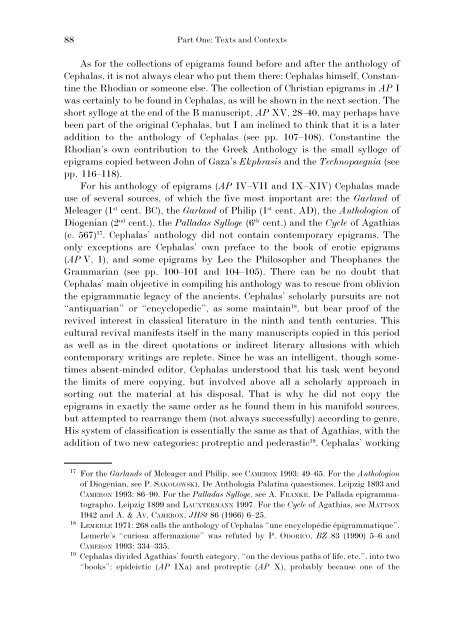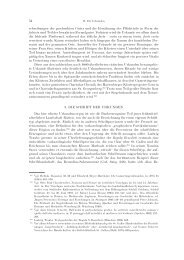Chapter Three ANTHOLOGIES AND ANTHOLOGISTS Between c ...
Chapter Three ANTHOLOGIES AND ANTHOLOGISTS Between c ...
Chapter Three ANTHOLOGIES AND ANTHOLOGISTS Between c ...
You also want an ePaper? Increase the reach of your titles
YUMPU automatically turns print PDFs into web optimized ePapers that Google loves.
88<br />
Part One: Texts and Contexts<br />
As for the collections of epigrams found before and after the anthology of<br />
Cephalas, it is not always clear who put them there: Cephalas himself, Constantine<br />
the Rhodian or someone else. The collection of Christian epigrams in AP I<br />
was certainly to be found in Cephalas, as will be shown in the next section. The<br />
short sylloge at the end of the B manuscript, AP XV, 28–40, may perhaps have<br />
been part of the original Cephalas, but I am inclined to think that it is a later<br />
addition to the anthology of Cephalas (see pp. 107–108). Constantine the<br />
Rhodian’s own contribution to the Greek Anthology is the small sylloge of<br />
epigrams copied between John of Gaza’s Ekphrasis and the Technopaegnia (see<br />
pp. 116–118).<br />
For his anthology of epigrams (AP IV–VII and IX–XIV) Cephalas made<br />
use of several sources, of which the five most important are: the Garland of<br />
Meleager (1 st cent. BC), the Garland of Philip (1 st cent. AD), the Anthologion of<br />
Diogenian (2 nd cent.), the Palladas Sylloge (6 th cent.) and the Cycle of Agathias<br />
(c. 567) 17 . Cephalas’ anthology did not contain contemporary epigrams. The<br />
only exceptions are Cephalas’ own preface to the book of erotic epigrams<br />
(AP V, 1), and some epigrams by Leo the Philosopher and Theophanes the<br />
Grammarian (see pp. 100–101 and 104–105). There can be no doubt that<br />
Cephalas’ main objective in compiling his anthology was to rescue from oblivion<br />
the epigrammatic legacy of the ancients. Cephalas’ scholarly pursuits are not<br />
“antiquarian” or “encyclopedic”, as some maintain 18 , but bear proof of the<br />
revived interest in classical literature in the ninth and tenth centuries. This<br />
cultural revival manifests itself in the many manuscripts copied in this period<br />
as well as in the direct quotations or indirect literary allusions with which<br />
contemporary writings are replete. Since he was an intelligent, though sometimes<br />
absent-minded editor, Cephalas understood that his task went beyond<br />
the limits of mere copying, but involved above all a scholarly approach in<br />
sorting out the material at his disposal. That is why he did not copy the<br />
epigrams in exactly the same order as he found them in his manifold sources,<br />
but attempted to rearrange them (not always successfully) according to genre.<br />
His system of classification is essentially the same as that of Agathias, with the<br />
addition of two new categories: protreptic and pederastic 19 . Cephalas’ working<br />
17 For the Garlands of Meleager and Philip, see CAMERON 1993: 49–65. For the Anthologion<br />
of Diogenian, see P. SAKOLOWSKI, De Anthologia Palatina quaestiones. Leipzig 1893 and<br />
CAMERON 1993: 86–90. For the Palladas Sylloge, see A. FRANKE, De Pallada epigrammatographo.<br />
Leipzig 1899 and LAUXTERMANN 1997. For the Cycle of Agathias, see MATTSON<br />
1942 and A. & AV. CAMERON, JHSt 86 (1966) 6–25.<br />
18 LEMERLE 1971: 268 calls the anthology of Cephalas “une encyclopédie épigrammatique”.<br />
Lemerle’s “curiosa affermazione” was refuted by P. ODORICO, BZ 83 (1990) 5–6 and<br />
CAMERON 1993: 334–335.<br />
19 Cephalas divided Agathias’ fourth category, “on the devious paths of life, etc.”, into two<br />
“books”: epideictic (AP IXa) and protreptic (AP X), probably because one of the




